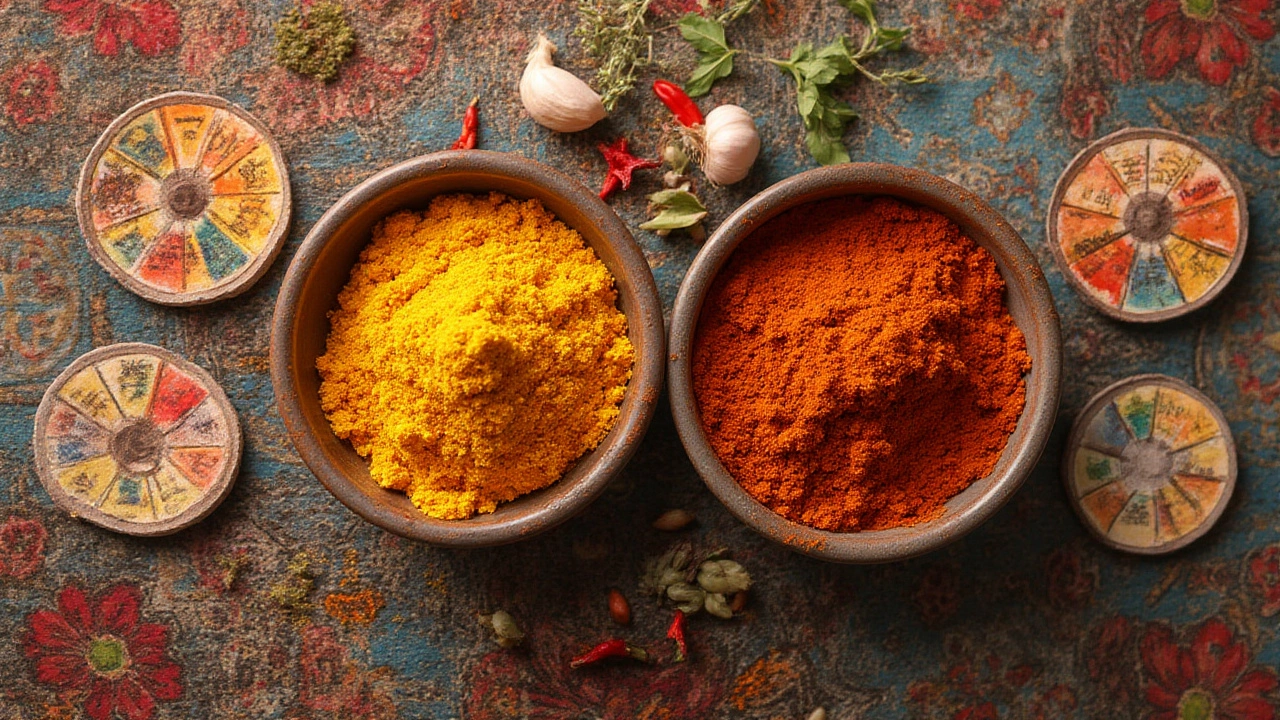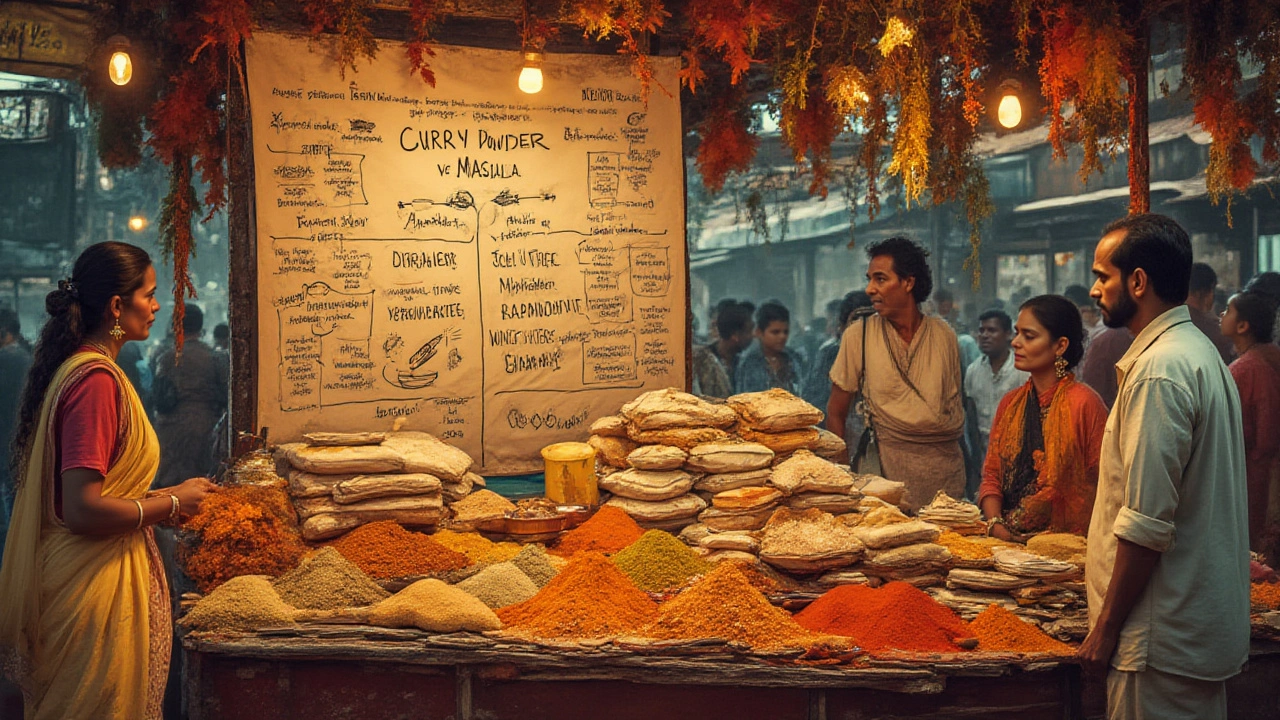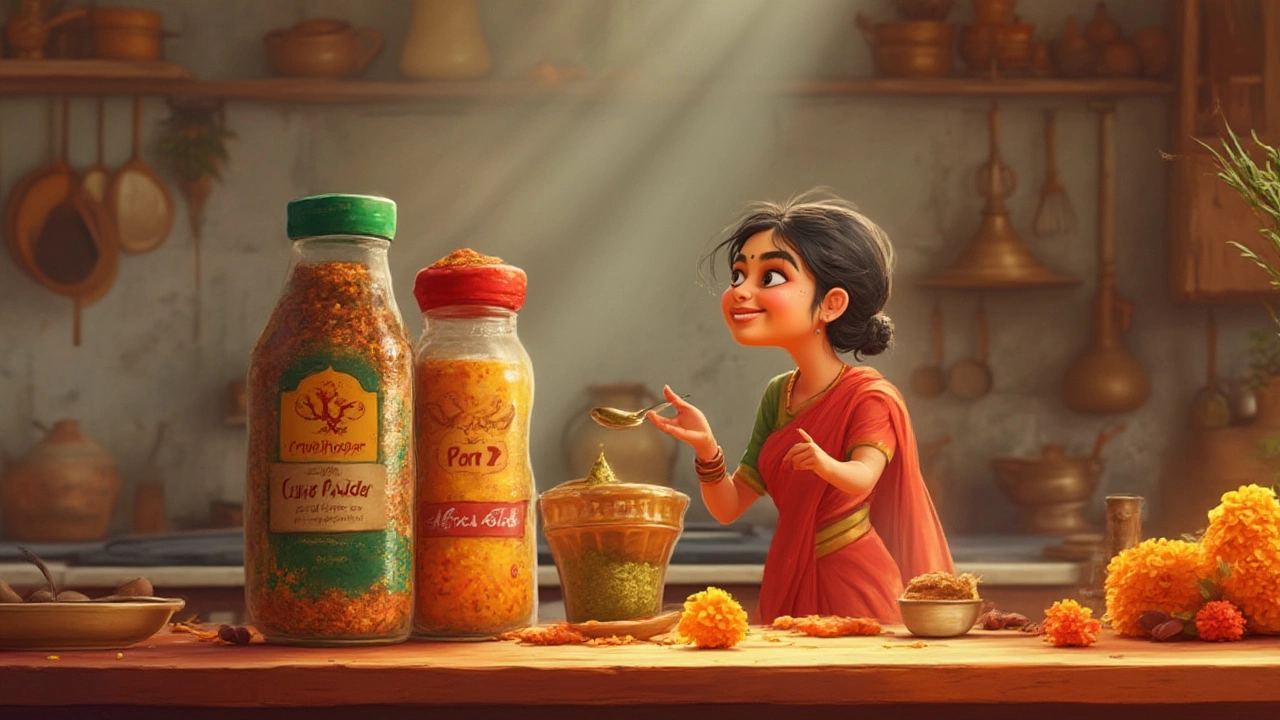Ever stared at a recipe calling for garam masala, but only spotted curry powder sitting lonely in the back of your pantry? The debate over whether you can swap these classic spice blends isn’t new, but here’s a twist—most people don’t realize the switch-ups actually change more than just taste. While both blends look similar, they unlock totally different moods in a dish. If you think adding curry powder to butter chicken will ‘do the job,’ you might be setting yourself up for a kitchen curveball!
Understanding the Spice Blends: What’s Actually in Curry Powder and Masala?
Let’s start with the basics. Think of curry powder and masala as cousins—they share roots, but they’re raised in totally different families. Curry powder, as you see it in stores in the US or UK, isn’t actually something traditional Indian cooks use at home. It’s a British invention, made to echo the flavors British colonialists fell for in India. The standard mix usually features turmeric (that’s why it’s yellow), coriander, cumin, fenugreek, dried mustard, ginger, black pepper, and a hit of chili. This is why curry powder brings a warm, earthy, often slightly sweet edge.
Now, masala (especially garam masala) is the real deal straight from Indian kitchens. The word ‘masala’ just means ‘spice mix’ in Hindi, and there isn’t one set recipe. Families guard their own versions like a secret vault. The iconic garam masala often blends cinnamon, cloves, black and green cardamom, cumin, coriander, nutmeg, and bay leaf. Sometimes it’s toasted, sometimes not. The aroma is complex and heady, and the taste leans much more toward warm, aromatic, and sometimes even floral.
Check out the main difference in their contents and flavor profiles below:
| Spice Blend | Typical Ingredients | Flavor Profile |
|---|---|---|
| Curry Powder | Turmeric, coriander, cumin, fenugreek, mustard seeds, black pepper, ginger, chili | Earthy, warm, mild to spicy, yellow |
| Garam Masala | Cinnamon, cloves, cardamom, cumin, coriander, nutmeg, bay leaf, peppercorn | Fragrant, warm, spicy-sweet, brown |
If you swap one for the other, those subtle deep flavors of a North Indian curry, especially in recipes like tikka masala or korma, might just fade into the background, replaced by a more generic curry-hall scent. There’s nothing wrong with that if you’re hungry and short on time, but you should know exactly what you’re getting yourself (and your dinner guests) into.
Will the Substitute Work? What Happens When You Swap Curry Powder for Masala?
So, here’s the big question: If your recipe tells you to use garam masala but you only have *curry powder*, can you just do a one-to-one swap? Not exactly. Swapping these two spice blends is a bit like reaching for orange soda when you actually wanted cola. Similar, but the wrong notes hit your taste buds.
Curry powder tends to be heavier on turmeric and mustard seeds, which gives any dish a strong ‘yellow curry’ color, and a mild, slightly bitter flavor. Garam masala, on the other hand, is noticeably richer and more aromatic—it usually hits you with bursts of cloves and cardamom, and rarely brings bitterness. So if you use curry powder in a butter chicken, you’ll get a pretty nice dish, but it probably won’t taste much like a restaurant-style makhani. In fact, famous Indian chef Madhur Jaffrey has called curry powder “a British solution for the Indian flavor,” hinting that it’s useful, but not the real deal for authentic flavor.
With that said, if you’re cooking something more flexible—think scrambled eggs, roasted veggies, or a homemade soup—a dusting of curry powder can give you a similar kick as masala, especially if you boost the flavor with a little extra ground cinnamon or a crushed clove. Just be aware, your food will look and smell more like classic Anglo-Indian curry, and less like a dish from a Delhi home kitchen.
Someone did the test: A 2023 home cook challenge tried swapping curry powder for masala in five classic Indian dishes. Result? It worked okay in fusion recipes (like curried chicken salad or chickpea stew), but fell short on the classic North Indian gravies. So yes, you can substitute—but expect a shift!

How to Adjust Recipes When Substituting: Practical Tips and Ratios
Alright, so you’re going for the swap—maybe out of necessity, maybe for some creative kitchen chaos. Here are a few helpful tips to dodge disaster and keep your meal tasting great:
- Use less curry powder than masala. Start with half the amount, then adjust to taste. Curry powder can quickly overpower some dishes, especially if it packs extra chili.
- Add a pinch of cinnamon or ground cloves to your curry powder to mimic the warmth of garam masala. Even a little cardamom (just the seeds, crushed) makes a big difference.
- For creamy dishes (like butter chicken or tikka masala), stir in a little ground nutmeg for a richer, rounder flavor.
- Instead of adding curry powder at the end (like you would with garam masala), toss it in earlier during the cooking process. This cooks out the harshness of turmeric and mustard, making the flavor blend better.
- If you’re worried about losing authentic color, sprinkle in some paprika for warmth, or a tiny pinch of smoked paprika if you want that tandoori-smoke vibe.
As for measurements, here’s a handy guide:
| If the recipe calls for... | Try using this |
|---|---|
| 1 tablespoon garam masala | 1/2 to 2/3 tablespoon curry powder + 1/4 teaspoon cinnamon + pinch of cloves |
| 1 teaspoon curry powder | 1 teaspoon garam masala (for a different, warmer edge) |
Don’t stress if your dish tastes a little different—sometimes the best new recipes happen by accident.
When Not to Substitute: Dishes That Need the Real Thing
This all sounds handy, but some recipes just refuse to play nice if you swap curry powder for masala. Classic dishes—think chicken tikka masala, paneer butter masala, or biryani—build their entire identity around layers of specific spices. Curry powder won’t bring out the signature aroma or depth. The difference isn’t just flavor, but color and texture too.
Take chana masala (spiced chickpeas), for example. The punchy masala blend gives it that thumbprint of North India. Toss in curry powder instead? You’ll get a delicious curried chickpea stew, just not the true chana masala your friends might expect. Same goes for samosas and pretty much any street food recipe that relies on a complex masala base slammed with freshly ground spices.
On the flip side, curry powder slides in nicely in soups, stews, egg salads, and even some fusion dishes. There’s a reason so many UK curry house classics—like coronation chicken—use curry powder as their base. It’s reliable, forgiving, and brings familiarity, if not authenticity.
Here’s a fast list of must-not-swap dishes:
- Classic Indian gravies: Chicken tikka masala, paneer makhani, butter chicken
- Street food staples: Samosas, pav bhaji
- Biryani or pulao (fragrant rice dishes)
- Traditional dal (especially dal makhani)
If you’re yearning for the ‘real’ flavor, your best bet is to hunt down a packet of actual masala or make your own at home—just toast and grind up the classic spices. It’s possible, and honestly, once you start a homemade masala habit, you’ll never turn back.

Smart Shopping and DIY Spice Blending Tips
When you’re stocking up on spices, don’t just grab the cheapest label you see. Quality matters—a lot. Pre-ground curry powder from a regular grocery store shelf might be sitting there for months, so it can be stale or muted. For fresher flavors, check Asian grocers or Indian markets. They often turn over their stock quicker and carry more nuanced blends.
If you’re feeling bold, try making your own versions of both curry powder and garam masala. It sounds intimidating, but it’s totally doable—no special gear needed, just a pan and a grinder (or even a mortar and pestle):
- For quick curry powder: Mix 2 parts ground coriander, 1 part turmeric, 1 part cumin, 1 part mustard powder, 1 part fenugreek, a pinch of chili powder, and black pepper. Toast the mixture gently for fresher flavor, if you like.
- For garam masala: Blend 2 parts cinnamon, 2 parts cardamom seeds, 1 part cloves, 1 part cumin, 1 part coriander, and a pinch of nutmeg. Toast whole spices before grinding if you want to amp up the aroma.
Keep these blends in airtight jars, away from sun and heat. Ground spices lose their aroma after six months or so. A 2024 TasteAtlas survey showed that homemade masalas scored double in flavor ratings compared to most pre-ground supermarket blends. That tiny bit of effort genuinely pays off.
Here’s a tip: Write the ‘blended on’ date on your spice jars, so you know when it’s time for a refresh. Trust me, your next curry will absolutely thank you for it!
